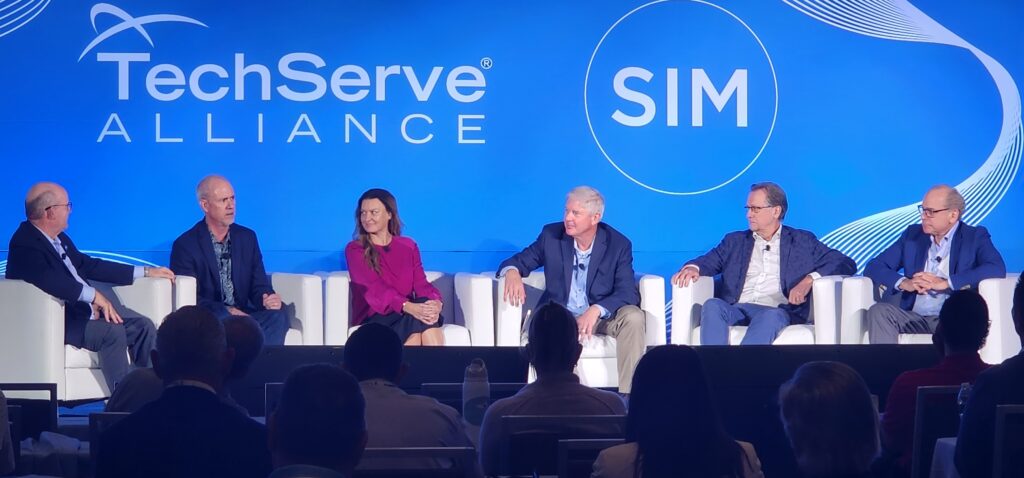
2024: Where We Are, Where We’re Going
Leading CIOs, Staffing Leaders & IT Procurement Professionals on the State of Technology Moving into 2024
As the technological landscape continues to evolve, the year 2024 brings forth many opportunities as well as challenges for both the broader technology industry and its indispensable counterpart, the technology staffing sector. From navigating the intricate terrain of talent acquisition amid persistent skill shortages to confronting the dynamic impacts of emerging technologies, the stakes have never been higher.
TechServe Alliance brought together a panel of IT leaders and technology staffing executives at the TechServe Alliance Executive Summit, held in conjunction with the Society for Information Management (SIM)’s executive leadership conference TechExec 2023. The group delved into some of the most pressing issues shaping the tech landscape and shared their perspectives on current industry trends impacting those who employ and supply technical talent. From a pullback in budgets in some sectors, and ongoing talent shortages in many skill sets, to the impact of AI, the panel attempted to make sense of the dynamic economic, talent, and technology landscape.

The panel was moderated by Mark Roberts, CEO of TechServe Alliance, and Mark Taylor, CEO of the Society for Information Management (SIM). The panelists were:
- Joe Bruhin, CIO, Breakthru Beverage
- John Manzanares, CIO, Curaleaf
- Bruce Morton, Head of Strategy, Allegis Global Solutions
- Amy Schulz, Sr. Director Global Procurement, Hallmark Cards, Inc.
Here are some of the highlights and the thoughts of the panelists:
Price and margin compression is forcing businesses to optimize, and become more lean and agile
While the past several years have seen historic levels of hiring and investment in technology, businesses in most industries are pulling back and being more discretionary with investments.
“When you look at our research,” Mark Roberts says, “it’s ‘everything, everywhere, all at once’. There are many mixed signals and mixed messages. Take us through some of the things you’re seeing in terms of the economy, your business, and how it’s affecting IT projects, hiring, and availability of talent.”
We’ve been through a major transformation over the past five and a half years. That transformation has been to take out the cost, make sure that we can afford a lot of our new investments. We’re becoming much more digitized.
– Amy Schulz
We’re seeing price compression. Like many businesses, we go through cycles of heavy growth. Now, we’re going through a bit of optimization. We’re trying to make better, smarter choices around where we spend our money, where we invest, and where we divest. Is it driving revenue? Is it going to optimize costs? Is it going to help us use resources and assets more effectively? Or is it mitigating risk? If it doesn’t hit on one of those four things, then why are we doing it?
– John Manzanares
Help your teams, and the organization as a whole, understand the things that you should just plain stop doing. It’s about prioritization. Getting your organization aligned to the things that are going to move the needle farthest and fastest, and clear everything else out of the way.
– Joe Bruhin
There are continued challenges in recruiting talent, particularly those with difficult-to-find skill sets
Although the pace of hiring has slowed, we’re still facing record-low unemployment -particularly in IT – and niche skills are in very high demand. “With IT unemployment hovering around 1.9%,” asks Mark Taylor, “how concerned are you about finding and hiring the talent you need?”
We still need people, we’re still going to be bringing people in. Maybe not at the same pace as we were for the last few years. But the demand is still there. And at 1.9% unemployment, it’s hard to find those people.
– John Manzanares
We’re entering a period where we’ve run out of people. That’s it, we’re done. The only way you’re going to get business now is taking it from your competitor. The pie isn’t getting any bigger. If the people aren’t out there, you can’t put them to work.
– Bruce Morton
The transition to more hybrid and remote work is ongoing, and managing employee burnout is more important than ever
The pandemic caused a spike in the number of employees working remotely, part or all of the time, and predictions suggest that remote is here to stay. Some companies, however, haven’t gotten the message.
“In a recent LinkedIn report, only 11% of job postings advertised remote opportunities,” says Mark Roberts. “But 47% of applicants are looking for those positions. How is the transition to hybrid and remote work happening in your business?”
We’re trying to get people to come back. They go to their desk, they turn on their Teams, and they have meetings with people just like they would at home. Frankly, they get frustrated if we ask them to come into the office and do the same thing. I didn’t see a single decline in productivity over the two-plus years that we were all sitting at home. So let’s let people work where they feel they’re most productive.
– Joe Bruhin
We want people to see that it’s okay to take the dog for a walk when you’re on a conference call. And that you don’t have to feel guilty about going to the gym for an hour, because your boss does that too. That’s what we’re working on, trying to get people to take those breaks.
– Bruce Morton
The current level of burnout challenges every manager to be more sensitive and empathetic to what’s going on in your employee’s life.
– John Manzanares
Even if it’s ten minutes at the top of the meeting, Hallmark’s great at this. I mean, their motto is caring, connected lives. So they’re very good at that. I’m trying not to lose that in the culture as we’re not face-to-face as much. We do that through virtual coffee, virtual happy hours, that sort of thing.
– Amy Schulz
How AI technologies are being deployed in businesses now, and how they could be in the future
There’s little question that AI will change the way business is done in every industry – staffing and otherwise. Businesses of all types are incorporating these technologies today, and more will follow. “When you think about generative AI and its effect on your business,” Mark Taylor asks, “is it all that it’s hyped up to be, or no?”
Deconstruct the work into tasks. What skills are required to do that work? What can be automated? What could be done by AI, and what should be done by an employee?
– Bruce Morton
We’re looking at AI from a procurement perspective. How can I get the first draft of a contract 90% there, to the point where people need to look at it?
– Amy Schulz
Whether it’s RPA, machine learning, or chatbots, how can we make people more effective? It’s not going to replace you, it’s going to help augment you. It’s going to make you more effective, and take away the boring, mundane jobs you don’t like doing anyway.
– John Manzanares
Predictions for the economy and businesses in the coming year
Economic uncertainty is reflected in the business decisions being made now, and will do so for the near future. “There are indications of a recovery beginning early next year,” Roberts says, “but the last year or two have been challenging and very unpredictable. How has that affected your business, and how are you responding?”
The economy is weird, it’s unpredictable. You see 1.9% unemployment, but nobody wants to move. I think one of the reasons people don’t want to move is because they’re afraid of the economy. GDP is up, inflation went down a bit, home sales are up, prices are staying up, mortgage rates are going up. We haven’t seen these things before in this combination. It’s causing people to hunker down a bit.
– Joe Bruhin
We’ve got about 130 MSP programs around the world, and it’s obviously down in 2023. We think it’s flattened. We don’t believe there’s worse to come, but our prediction for next year is flat.
– Bruce Morton
The future is going to change; we don’t know what that’s going to look like. You need talent that are curious, and continual learners, and willing to challenge things.
– John Manzanares
Did you miss out on this year?
The agenda for the 2023 TechServe Alliance Executive Summit and SIM TechExec 2023 was filled with events like this panel discussion: insight and knowledge-sharing between industry peers, and opportunities to connect while building and strengthening relationships with colleagues. Did you miss the Summit this year? Start making plans now to travel to attend in 2024! This year’s Summit is scheduled for Nov. 18-20, at the Fairmont Scottsdale Princess Resort in Scottsdale, AZ.
